Podocarpus elongatus
Podocarpus elongatus (Ait.) L'Herit. ex Pers.
Family: Podocarpaceae
Common names: Breede River Yellowwood ( Eng. ), Breeriviergeelhout, westelike geelhout (Afr.)
SA Tree No: 15
Introduction
Many visitors to Kirstenbosch, remember the huge tree on the main lawn whose crown reached down to the ground and created a magical private sanctuary for anyone who stepped inside. This tree is a Breede River yellowwood, nearly as old as the Garden itself. It was planted as one of a pair, but the other one, equal in magnificence, was unfortunately blown down during a severe winter storm in May 1984.
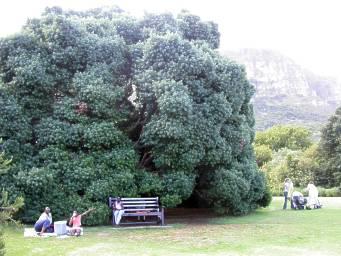
On Tuesday 1 November 2005 a gale force North West wind hit Cape Town, blowing down the 'Magic Tree'. The wind split it in two pieces, exposing the roots and breaking many of the branches.

This event was met with much sadness by everyone that knew and loved the tree. But, instead of chopping it up and consigning it to the compost heap and woodstack, like its twin that blew down in 1984, Kirstenbosch staff decided to try to save it. It was cordoned off from the public to prevent both additional damage to the tree and potential accidents as we were not sure how stable it was. Tree experts were consulted, a percentage of the crown was cut back, some of the boughs were braced, the exposed roots were covered with soil and regularly watered, and we watched and waited. Although the newly exposed parts of the canopy showed signs of sunburn, it was not long before new shoots sprung up all over the now exposed old trunks. If it had been any one of our other species of yellowwood it would probably have died but Podocarpus elongatus has the ability to resprout from epicormic buds - i.e. buds on the trunk of the tree.
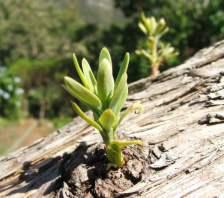
Description
Description
Unlike the other yellowwoods that are tall trees with long straight boles, Breede River yellowwoods are usually multi-stemmed and as broad as they are high. It is the smallest of the South African yellowwoods, commonly reaching no more than 6 m in height, although trees in sheltered, well-watered ravines can reach 20 m. It is most often found growing in open, dry and exposed positions where it develops into a large gnarled bush or spreading shrub, or a small rounded tree.
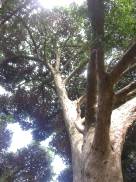

The bark is smooth, grey to brown, sometimes peeling longitudinally in long narrow strips. Leaves are narrowly oblong-elliptic, usually 30 - 60 mm long and 3 - 5 mm broad, tapering to both apex and base, tough and leathery. They are spirally arranged and are usually crowded towards the ends of the shoots. Juvenile trees may have larger leaves. The foliage is blue-green or grey-green; trees from Clanwilliam and Ceres districts generally have more silvery-grey leaves than those from the Swellendam and Robertson districts. At Kirstenbosch many of the specimens that are in the garden were selected for their glaucous foliage (i.e. the greyish-blue bloom on the leaves).
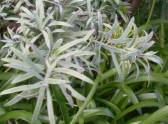
Yellowwoods are dioecious, i.e. there are male trees and female trees. Male cones are about 25 x 3 mm, cream to pinkish when fresh and are solitary or in groups of 2 - 5 in leaf axils. They are made up of many spirally arranged scales, each scale bearing two pollen sacs on its lower surface. The female cones are solitary, also borne in the leaf axils, on a naked (i.e. it bears no leaves or scales) stalk 4-6 mm long. The female cone is reduced to 1 or 2 fertile scales, each bearing 1 seed, that sit on top of a conical fleshy receptacle 9-15 x 10-16 mm that is actually a few sterile scales that have fused with each other and with the cone axis.
The receptacle is glaucous green turning to bright scarlet when the seed is ripe ageing to almost black. The seeds are smallish dark blue-green to dark violet berries with a leathery shell, 7-10 mm in diameter. The seeds mature rapidly and are on the trees in late summer to autumn (from January to May). The seed does not remain viable for long and should to be sown soon after it is ripe. Germinated seedlings have 2 cotyledons.
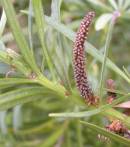

This species is closely related and very similar to Podocarpus latifolius , the true yellowwood, and they are often difficult to identify where their ranges overlap. A way to distinguish them is to look for the scattered stomata (pores) on the upper surface of P. elongatus leaves - you will find them in longitudinal grooves on the upper surface of most leaves. The grooves are usually near the margin or the petiole and are visible to the naked eye but you will need 10x lens to see the stomata.
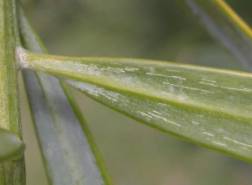
Both species have stomata on the lower surface of the leaves, but on Podocarpus latifolius they are very few to none on the upper surfaces. In general, the leaves of Podocarpus elongatus tend to be narrower and shorter, and more greyish to bluish and less shiny than Podocarpus latifolius. Also Podocarpus latifolius male cones are not found in groups but only singly or in pairs.
Distribution and habitat
Distribution description
Podocarpus elongatus is confined to the winter-rainfall Western Cape . It occurs from the Van Rhynsdorp area in the north through the Cedarberg and Bokkeveld Mountains to Swellendam in the south and does not occur naturally on the Cape Peninsula. It is found growing on deep sandy soils, often along rivers and streams. Large trees can be seen on the banks of the Breede River at the Bontebok National Park near Swellendam. Podocarpus elongatus is the only member of the family that is endemic to southern Africa.
Derivation of name and historical aspects
History
The name Podocarpus is derived from the Greek podo- foot and karpos fruit, in reference to the fleshy 'foot', the receptacle, on which the fruit of some species develops. In fact Podocarpus elongatus was the first southern African yellowwood to be scientifically recognised and was chosen as the type species for the genus. Elongatus means drawn out in length, elongated or lengthened in Latin.
The genus Podocarpus belongs to the group of conifers that does not produce cones, but carry their seeds in round shells with a fleshy skin. The yellowwood family (Podocarpaceae) has 17 genera and approx. 125 species that occur mainly in the Southern Hemisphere in the tropics and subtropics with a few members extending into the temperate areas. The genus Podocarpus consists of nearly 100 species but there are only four species that occur in southern Africa: P. falcatus (Outeniqua yellowwood), P. henkelii (Henkel's or KwaZulu-Natal yellowwood), P. latifolius (true yellowwood) and P. elongatus ( Breede River yellowwood).
Ecology
Ecology
Podocarpus elongatus is wind pollinated. It may be a primitive method, but is far from ineffective or random. A recent study shows that female P. elongatus ovules selectively extract P. elongatus pollen from the air; even though the air contains pollen from other species 98.9% of the sampled ovules contained only P. elongatus pollen. The foreign particles in 1.1% of the ovules were particles of black carbon and tiny grains of sand - no foreign pollen grains were found. Furthermore, one of the tree being studied was isolated and quite far from any male trees yet the ovules were pollinated.
The seeds are eaten and dispersed by small mammals and birds that relish the juicy brightly coloured receptacles. The leaves show adaptations to surviving in a dry environment - they have a thick cuticle, a layer of wax covering the leaves, resin canals, sunken stomata and conspicuous supporting tissue.
P. elongatus has adapted to growing beside rivers and streams which are notoriously unstable - riverside plants are often partially up-rooted, knocked over or damaged by floods or rocks carried in the water, washed downstream when river banks subside etc. As a result it has evolved a survival strategy that the other southern African yellowwoods have not - it has the ability to resprout from epicormic buds i.e. buds on the trunk of the tree. In an undamaged tree with a full canopy these buds lie dormant, but if a tree falls or is knocked over or the crown is damaged and the trunks are exposed to the heat and light of the sun they spring to life sending out shoots that grow into branches that eventually repair the damage. Eugene Moll - personal communication
Uses
Use
Although the Breede River yellowwood produces good timber, comparable to that of the others, it is not of great economic importance because large straight pieces can seldom be obtained. It has a darker reddish tinge than the others and has many more knots thanks to its gnarled shrubby habit. Wood-turners and chair-makers used large quantities of it in the past, as did the wagon-builders around Swellendam.
Growing Podocarpus elongatus
Grow
The Breede River yellowwood is tougher and more drought-resistant than the other South African yellowwoods and makes a handsome medium-sized garden tree. The fruits on female trees will attract a variety of birds to the garden.
Fresh seed must be sown soon after harvesting, in late summer-autumn. Refrigeration will extend the life of the seed but not beyond a few months. Many of them, particularly those that are produced first, are parasitised. Waiting and collecting the later seeds usually produces more viable seeds. Sow into deep (10 cm) trays and keep them moist and shaded. The young seedlings should be kept in the semi-shade for at least two years before transplanting. This tree can also be propagated by tip cuttings taken in spring and placed in a mist house, but we have found that they do not transplant easily.
References
- Palmer, E. and Pitman, N. 1972 Trees of Southern Africa . A.A. Balkema, Cape Town.
- van Wyk, P. & van Wyk, B. 1997 Field Guide to the Trees of Southern Africa. Struik Publishers, Cape Town
- Jackson , W.P.U. 1990 Origins and Meanings of Names of South African Plant Genera. U.C.T. Printing Dept., Cape Town.
- Coates Palgrave, Keith. 2002 Trees of Southern Africa, Third edition. Struik Publishers, Cape Town.
- Flowering Plants of Africa 50: pl. 1966
- Leistner, O.A. (ed.) 2000 Seed plants of southern Africa: families and genera, Strelitzia 10. National Botanical Institute, Pretoria.
- Nieuwmeyer, Hans 2002 The Aerodynamics of Wind Pollination, Veld & Flora 88(2):73
Credits
Christien Malan & Alice Notten
Kirstenbosch National Botanical Garden
January 2005
Plant Attributes:
Plant Type: Shrub, Tree
SA Distribution: Western Cape
Soil type: Sandy
Flowering season:
PH: Acid
Flower colour:
Aspect: Full Sun, Morning Sun (Semi Shade), Afternoon Sun (Semi Shade)
Gardening skill: Average
Special Features:
Horticultural zones











Rate this article
Article well written and informative
Rate this plant
Is this an interesting plant?
User Comments
Nico , South Africa
October 13, 2017 at 10:26 AMDie artikel is baie interessant, MAAR, dis jammer dat daar nie 'n detail-foto van die stam en bas is nie - want dis een van die vernaamste kenmerke om 'n boom aan uit te ken.
Login to add your Comment
Back to topNot registered yet? Click here to register.